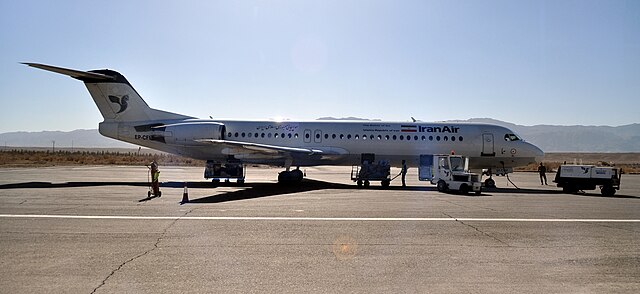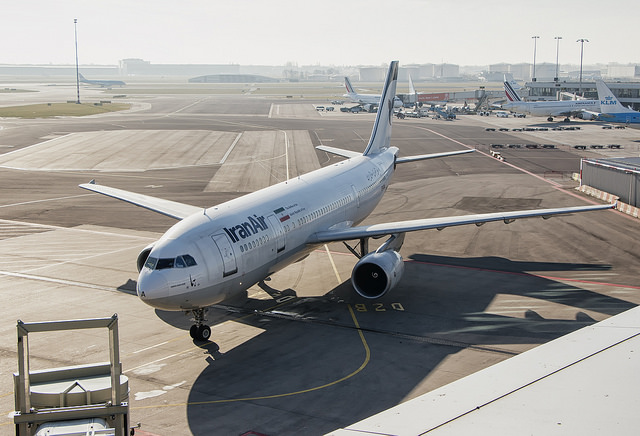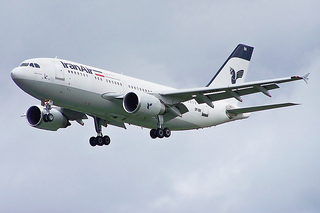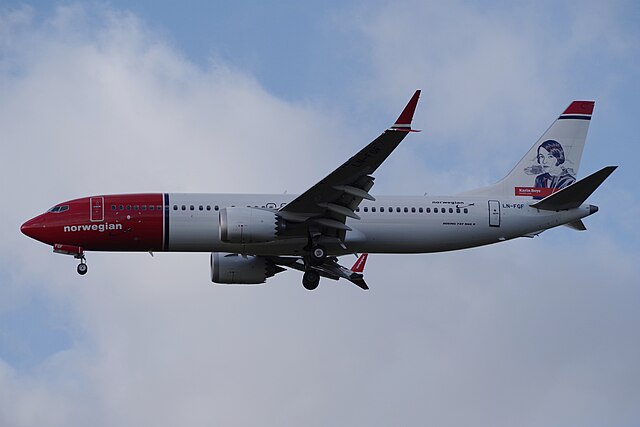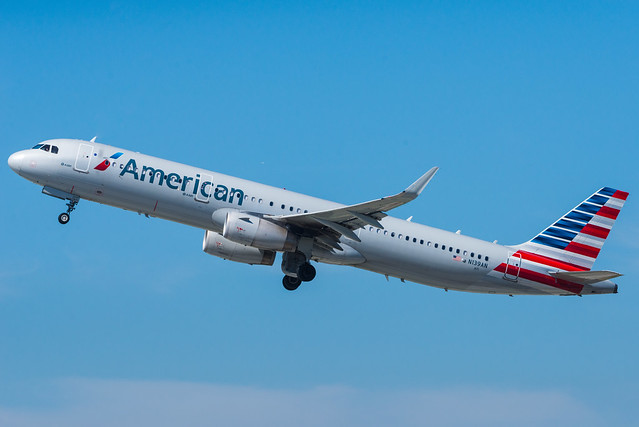Iran F100 at Tehran on Mar 19th 2019, main gear did not extend
Last Update: March 18, 2020 / 12:26:41 GMT/Zulu time
Incident Facts
Date of incident
Mar 19, 2019
Classification
Accident
Airline
Iran Air
Flight number
IR-215
Departure
Qeshm Island, Iran
Destination
Tehran Mehrabad, Iran
Aircraft Registration
EP-IDG
Aircraft Type
Fokker 100
ICAO Type Designator
F100
On Mar 21st 2019 Iran's AIB released a preliminary report in Persian stating the #1 hydraulic system had failed just as the aircraft began the descent towards Tehran. As result of the hydraulic failure the system could not release any of the landing gear struts. The crew worked the related checklists and attempted an alternate gear extension releasing the gear manually, however, only the nose gear was released that way, the main landing gear was not released. The crew therefore declared Mayday and performed a partial gear up landing. Following landing the passengers were evacuated from the aircraft, there were no injuries. No fire had occurred. With the assistance by Iran's military the aircraft was removed from the runway to a southern apron of the airport, the runway returned to service about 3 hours after landing. The aircraft had encountered 2 more occurrences involving the hydraulic system earlier, after the first event on Mar 16th 2019 an inspection and verification of engine performance was conducted prior to returning the aircraft to service, in the morning of the day of the accident the aircraft had suffered another hydraulic fault and underwent a technical review before being returned to service departing for Qeshm, the return flight from Qeshm resulted in the accident during which the hydraulic fault encountered in the morning repeated. Preliminary review suggests that operating the manual gear extension would be "difficult", this is focus of further investigation. The aircraft sustained substantial damage, including damage to the flaps and gear doors, the entire structure of the aircraft needs to be examined for possible structural damage. The ICAO, Dutch DSB (representing the aircraft manufacturer), the AAIB (representating the manufacturer of the landing gear) have beein informed and invited to join the investigation. As an immediate safety recommendation the AIB recommends to operators of Fokker 100 aircraft to test the manual landing gear extension procedure as result of low hydraulic pressure during the next maintenance or repair visit to a workshop.
On Mar 24th 2019 Iran's AIB released an Emergency Airworthiness Directive (see below) following this accident as well as another incident, see Incident: Iran Aseman F100 at Ilaam and Tehran on Mar 22nd 2019, right main gear did not extend, then by luck extended one last time.
On Mar 18th 2020 Iran's AIB released their final report concluding the probable cause was:
The aircraft involved accident due to the main gear up landing on the runway. The Aircraft Accident Investigation Board (AAIB) determines that the accident took place due to a combination of failures in hydraulic system and L/G manual extension.
The investigation revealed that the contributive factors in human failures were as:
- Not following procedures
- Ineffective maintenance
- Pilot nonstandard action to HYD #1 pump fault light based on QRH on previous flight IRA.214
The AIB described the sequence of events:
On flight No IRA214 from THR to GSM during final stage of climb before cruise phase approaching position "ANK", the cockpit crew encountered hydraulic pump #1 fault light on left engine. So, after co-ordination with onboard flight mechanic, they decided to switch off the relative engine driven Hydraulic pump then switched it on again. Therefore, the system came back to normal condition with consideration of enough pressure and fluid quantity in the approved limit.
The flight No IRA215 departed from GSM to the destination THR at 15:25UTC as a schedule flight with 24 passengers and 9 crew members. Fifteen minutes before descent, again the same failure on hydraulic system #1 occurred and also HYD low quantity warning was received. The crew switched off the related HYD engine driven pump and flight was continued to destination. While descending to Tehran, the related checklist was performed and the crew tried an alternate landing gear extension by releasing the gear manually. When the nose landing gear was released but the main gear doors were not opened, the crew declared an emergency due to partial gear up landing and requested holding to reduce aircraft fuel and preparing airport emergency facilities.
The crew performed a partial gear up landing and aircraft landed at 17:56 UTC on RWY 29L in Mehrabad International Airport on its nose gear and aft belly. After landing, passengers were evacuated safely from the aircraft with no injuries and no fire occurred either.
After the accident, the aircraft was removed from the runway to southern apron with the cooperation of involved airport emergency organizations and the RWY was returned to service about three hours after the accident.
On the next day, by lifting up the aircraft from the trolley cart, the main landing gear doors automatically opened and the main landing gears were lowered and locked. The aircraft was pushed to a hanger for further inspection and related analysis.
The captain (60, ATPL, 14,110 hours total, 8,093 hours on type) was pilot flying, the first officer (26, CPL, 190 hours total).
The AIB described the diagnostic steps performed:
The inspection showed that due to faulty check valves, the high pressure of hydraulic fluid occurred and caused pressure and temperature to rise in return line and consequently EDP case outlet pressure rose, EDP overheated and subsequently gasket no. 295 was dismantled from its original position and caused hydraulic "leakage".
Some other tests were done on the landing gear system by cooperation of the airline engineering department in two sections as:
a) Examination of landing gear alternate system:
- After aircraft was jacked up, the normal landing gear operation was performed with hydraulic electric pump "ON" and it was found that the main and nose landing gears extension and retraction as well as the respective doors' operations were normal.
- Landing gear alternate functional check was performed with hydraulic pressure available, and it was found that the main and nose landing gears and respective doors operation were normal.
- Landing gear alternate functional check was performed without hydraulic pressure and it was found that the operation of the nose landing gear and respective doors were normal but the main landing gear and respective doors did not open and also the mechanical handle needed too much force to perform the alternate landing gear operation (above maximum limitation about 90 lbs.). The scenario of accident was simulated again.
- Main landing gears' selector valve P/N: 71544-1 was changed, but the problem still persisted.
- Dump valve P/N: 71545-1 was changed, but the problem still persisted.
- Both main landing gear doors’ selector valves P/N: 71543 were changed, but the problem still persisted.
- In accordance with CMM: 32-31-04, page 176, item No.6, main landing gear doors uplock mechanisms were removed and sent to the accessory shop for further investigation. It was found that three uplock rollers seized specially on forward right-hand side door up-lock & sign of worn out and deformation on the holes of main landing gear up lock mechanism lever assembly. It caused hard movement of alternate extension lever.
- Referring the failure of up-lock door mechanism, the fine adjustment was performed and simultaneously the alternate mechanism was lubricated slightly and as a result the alternate lever force decreased to about 40 lbs. (within limits), leading to normal function of the landing gear alternate system.
b) Examination of hydraulic loss problem according to the defined task and engineering disposition was done, the following procedures were performed on hydraulic system of the aircraft:
- After hydraulic servicing, heavy external hydraulic leakage was found on ENG#1, system #1, pump case (between mating surfaces of front housing and pump case mounting flange)
- Engine#1 hydraulic pump (S/N off: B159AB) was changed with the new part
- For troubleshooting, the hydraulic pump (S/N off: B159AB), that was removed, was sent to hydraulic shop for more investigation.
- The shop report findings are as follow:
1- One of the front housing mounting flanges (FWD mating faces) bolts had been completely loosened and the others had lost their own tightening torque, which could be the sign of EDP overheating.
2- The front housing mounting flange (FWD mating faces) gasket was discolored and became brittle, and also a piece of the gasket which was missed caused the leakage to begin.
3- There were overheating symptoms on the corresponding gasket which indicates that the hydraulic pump cooling was not performed properly due to the case outlet "back pressure".
4- All internal parts of the hydraulic pump were in satisfactory conditions and free of any defects.
- In preliminary investigation it was found that the check valve P/N: MS24593-4; (F100 IPC Ref: 29-13-08-15A, item #60) was faulty which could have caused the drain line to become trapped, resulting in the pump overheat.
- The "return filter assembly" and "differential pressure switch" were removed and sent to hydraulic shop for free hydraulic flow check (by hydraulic tester) which were found to be OK.
- Eng#1 system#1 "case drain Q.A.D" & " union " were removed and sent to hydraulic shop for free hydraulic flow check and found OK.
- Regarding the above investigation, the Engineering Disposition (ED) was issued by engineering department that included instructions which are as follows:
1- The dimension of hydraulic lines which are connected to return manifold were measured and checked for general condition.
2- The hydraulic return line pressure value was measured and it was above 100 PSI, so system #1 return line filter check values and one of sys#1 return manifold check valve were removed and sent to hydraulic shop and all were found faulty; (the pressure drop through the check valves; at 40 lit/min was more than 15 PSI).
3- Regarding the above shop result, the mentioned check valves were changed and return line pressure valve was measured and found to be below 40 PSI within limits and normal condition.
Following a C-Check on Feb 1st 2019 the aircraft began suffering from hydraulic problems on Mar 16th 2019 with pump failures related to the left hydraulic system Engine Driven Pump (EDP) #1 and EDP #2. Mainteance activities were deactivation of the left hand thrust reverser under Minimum Equipment List requirements, circuit breaker resets, servicing of the hydraulic system, a hydraulic line was replaced, replacement of the EDP #1.
The AIB analysed:
Based on airline CAME, in case a defect is repeated 4 times in 10 flights, maintenance control center will derive a recurring defect report from database and analyze the defect and finally extract deadline and forward to CAMO manager’s delegate and engineering department for immediate action. It was the time that #1 hydraulic failed and due to not recording the HYD failure by the crew on flight 214, related recurrent defect notification was not issued.
All recorded events show that there was a hidden failure in No. 1 hydraulic system that was not detected by airline maintenance and related consequences appeared during flights before the accident. The revealed investigation of aircraft system after the accident determined the failure as:
The check valve P/N: MS24593-4; (F100 IPC Ref: 29-13-08-15A, item #60)as per AMM 29-00-00-811-811-A and engineering Disposition N; 1815/19 has been checked and found faulty which could have caused the drain line to become trapped, resulting in the pump overheat. Regarding this finding, some other research determined that measured hydraulic return line pressure value was above 100 PSI, so system #1 return line filter check values and one of sys#1 return manifold check valve were found faulty consequently; (the pressure drop through the check valves at 40 lit/min was more than 15 PSI). Finally, regarding the above shop results, the mentioned check valves were changed, and the return line pressure value was measured and found to be below 40 PSI with normal operation of No.1 hydraulic system.
Aircraft Trouble shooting Schematic Manual (TSM) defines only system diagram and technicians referred to AMM and the maintenance section of the airline based on AMM task No. 29-00-00-811-811-A changed the EDP. Related fault isolation procedure was not done accordingly that could detect failure respectively.
The airline should be concerned about repetitive similar events on No. 1 hydraulic system and make extensive troubleshooting on this system. Also, Fokker service Co. has not continued their cooperation/support with Iran air and the airline could not contact the manufacturer to follow up detection of the failure.
With respect to the failure of the alternate landing gear release the AIB analysed:
According to the design characteristic of the aircraft, the L/G should extend with their weight force normally, while alternate manual L/G extension by releasing uplock mechanism. All four door up-lock mechanisms of aircraft landing gears were focused on. In accordance with CMM:32-31-04, page 1076, item No.60 , rollers of the door up lock, especially in FW R/H position (3EA) found seized, which caused hard movement of alternate extension lever.
...
According to the Aircraft Technical Log (ATL) page 8132, the last check of this aircraft (C-06) had been done in Maintenance center. Some items in this heavy check are as follows:
- Door up-lock mechanism inspection.
- Functional test of landing gear alternate control system in accordance with task No; 32-32-00-720-815A.
- Door up-lock mechanism lubrication.
The alternate system did not work correctly after 297 flight cycles, and gear alternate extension lever moved hardly. In interview with personnel involved releasing this task, they insisted that the system worked normally but in MAX permissible limit.
Evidence such as the seized rollers, lever assembly deformation and up-lock mechanism failure may have emerged due to component aging and some other defects need adjustment and lubrication. Only 297 cycles and 327 hours of flight after “C” check could not have caused such an extensive failure on the alternate landing gear extension. It can be analyzed that periodical L/G inspections at the last maintenance action (C06 check) might not have been of good quality. The existence of each item mentioned above is indicative of the long time they took to occur; clearly, these problems did not happen suddenly.
Metars:
OIII 191930Z 29006KT 9999 FEW035 BKN100 08/00 Q1015 A2998=
OIII 191900Z 28008KT 9999 FEW035 SCT100 08/M00 Q1015 A2999 NOSIG=
OIII 191830Z 27008KT 9999 FEW035 SCT100 10/M00 Q1015 A2998=
OIII 191800Z 00000KT 9999 FEW035 11/M04 Q1015 A2998=
OIII 191730Z 00000KT 9999 FEW035 BKN090 11/M05 Q1015 A2998=
OIII 191700Z 30004KT 9999 FEW035 BKN100 12/M05 Q1015 A2998 NOSIG=
OIII 191630Z 31004KT 9999 FEW035 BKN100 12/M05 Q1015 A2998=
OIII 191600Z 26008KT 9999 FEW035 SCT100 12/M04 Q1014 A2997 NOSIG=
OIII 191530Z 27006KT 9999 FEW035 SCT100 12/M04 Q1014 A2996=
OIII 191500Z 26008KT 9999 FEW035 SCT100 13/M05 Q1014 A2996=
Incident Facts
Date of incident
Mar 19, 2019
Classification
Accident
Airline
Iran Air
Flight number
IR-215
Departure
Qeshm Island, Iran
Destination
Tehran Mehrabad, Iran
Aircraft Registration
EP-IDG
Aircraft Type
Fokker 100
ICAO Type Designator
F100
This article is published under license from Avherald.com. © of text by Avherald.com.
Article source
You can read 2 more free articles without a subscription.
Subscribe now and continue reading without any limits!
Read unlimited articles and receive our daily update briefing. Gain better insights into what is happening in commercial aviation safety.
Send tip
Support AeroInside by sending a small tip amount.
Related articles
Iran F100 near Tabriz on May 24th 2024, lightning strike, electrical problems and loss of cabin pressure
An Iran Air Fokker 100, registration EP-CFM performing flight IR-455 from Tehran Mehrabad to Tabriz (Iran) with 101 passengers and 9 crew, was…
Iran A306 at Tabriz on Oct 23rd 2023, smoke in cockpit and cabin
An Iran Air Airbus A300-600, registration EP-IBA performing flight IR-718 from Istanbul (Turkey) to Tehran Imam Khomeini (Iran), was enroute at FL330…
Iran A313 near Tehran on Jun 7th 2022, turbulence injures 2
An Iran Air Airbus A310-300, registration EP-IBK performing flight IR-718 from Istanbul (Turkey) to Tehran Imam Khomeini (Iran) with 200 passengers…
Iran F100 near Isfahan on Mar 4th 2021, hijack averted
An Iran Air Fokker 100, registration EP-CFM performing flight IR-334 from Ahwaz to Mashad (Iran) with 63 passengers and 4 crew, was enroute near…
Iran F100 at Tehran on Sep 14th 2016, nose gear collapsed during taxi
An Iran Air Fokker 100, registration EP-CFP performing flight IR-212 from Tehran Mehrabad to Birjan (Iran), was taxiing for departure still on the…
Newest articles
Norwegian B38M at Malaga on Nov 22nd 2025, another aircraft on landing runway
A Norwegian Air Shuttle AOC Boeing 737-8 MAX, registration LN-FGF performing flight DY-1800 from Oslo (Norway) to Malaga,SP (Spain) with 189 people…
American A321 near Houston on Nov 23rd 2025, fumes on board
An American Airlines Airbus A321-200, registration N139AN performing flight AA-2118 from Orlando,FL to Phoenix,AZ (USA), was enroute at FL320 about…
Subscribe today
Are you researching aviation incidents? Get access to AeroInside Insights, unlimited read access and receive the daily newsletter.
Pick your plan and subscribePartner

ELITE Simulation Solutions is a leading global provider of Flight Simulation Training Devices, IFR training software as well as flight controls and related services. Find out more.
SafetyScan Pro provides streamlined access to thousands of aviation accident reports. Tailored for your safety management efforts. Book your demo today
AeroInside Blog
Popular aircraft
Airbus A320Boeing 737-800
Boeing 737-800 MAX
Popular airlines
American AirlinesUnited
Delta
Air Canada
Lufthansa
British Airways
